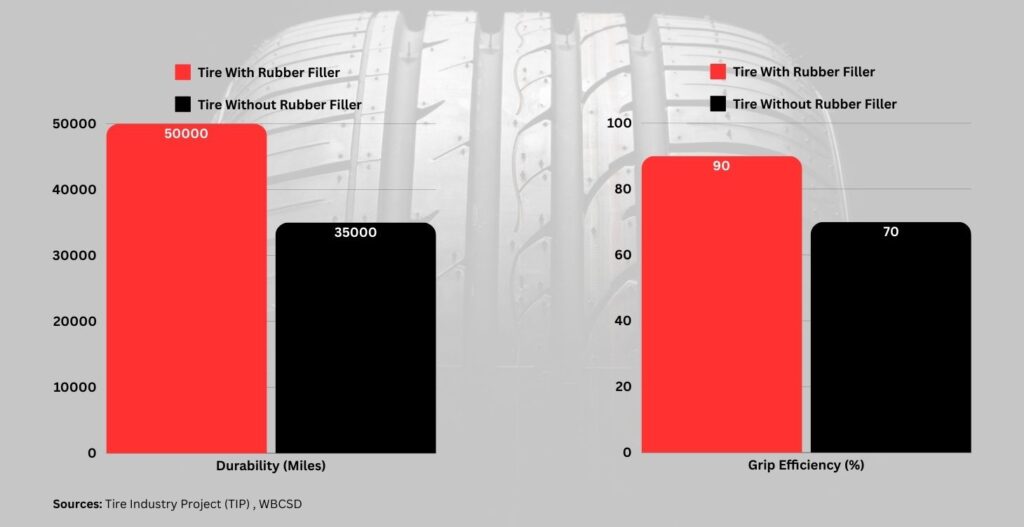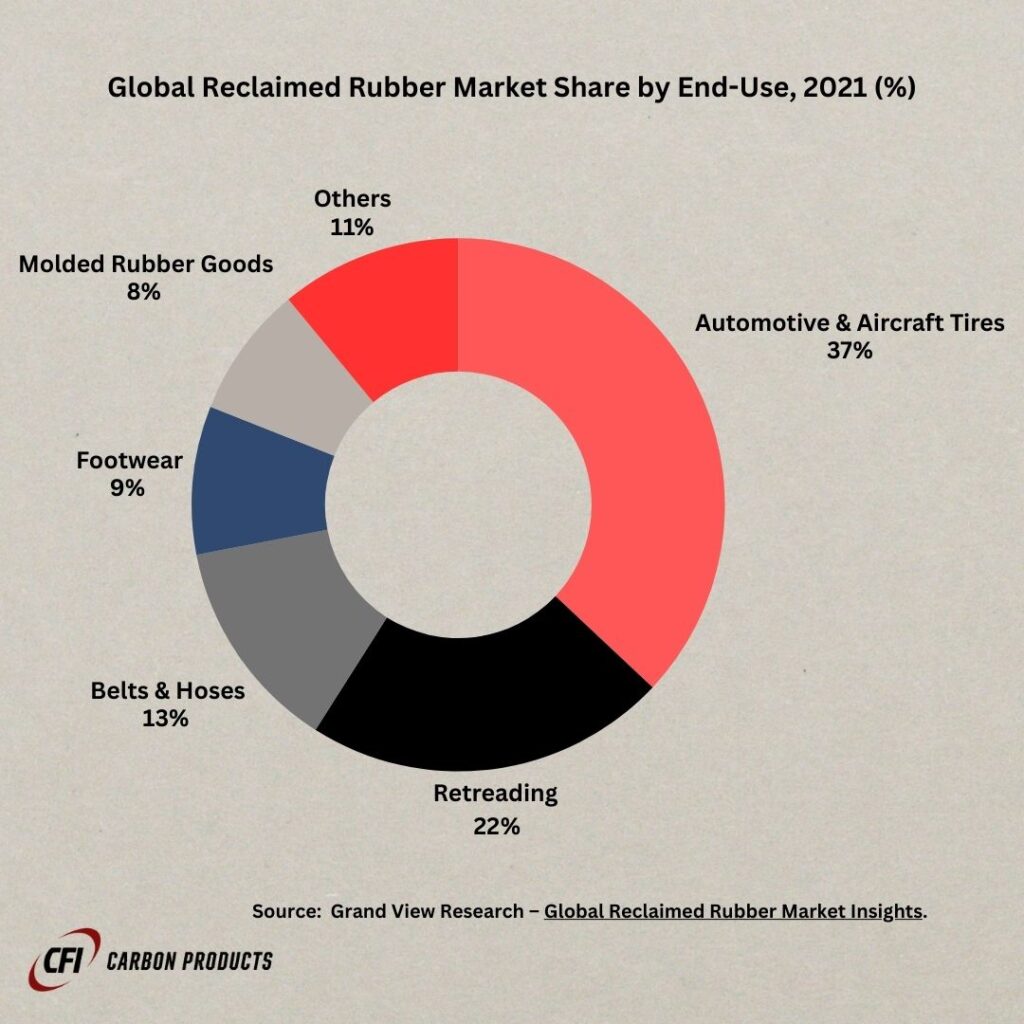Tire rubber fillers are essential ingredients in manufacturing high-performance tires, improving durability, heat resistance, and overall strength. These additives, like carbon black, have long been used to enhance the properties of rubber. However, as sustainability becomes a priority, manufacturers are turning to more eco-friendly alternatives.
In this article, we’ll explore what tire rubber fillers are, how they are made, and their role in the tire industry. We’ll also introduce Austin Black 325, a modern alternative that offers similar benefits to traditional fillers, but with a greener, more sustainable approach.
1- What is Tire Rubber Filler?
Tire rubber fillers are essential components in the manufacturing of high-quality tires. They are additives mixed with rubber compounds to enhance the performance and durability of the final product. These fillers help improve the rubber’s strength, wear resistance, and flexibility, ensuring that tires are capable of enduring the demanding conditions of everyday use, including high-speed driving, extreme temperatures, and exposure to various environmental elements.
Basic Components of Tire Rubber Fillers
Tire rubber fillers are typically made up of several key ingredients, each contributing a unique benefit to the rubber compound:
- Carbon Black: The most common tire filler, carbon black plays a significant role in enhancing the rubber’s durability and wear resistance. It also improves the rubber’s ability to withstand UV exposure and ozone, making it an ideal choice for tires that are subjected to harsh outdoor conditions.
- Silica: Another popular filler material, silica is often used as a more eco-friendly alternative to carbon black. It provides excellent rolling resistance and improves wet traction, but tends to be more expensive.
- Oils and Plasticizers: These ingredients help make the rubber more flexible and easier to process during manufacturing. They also contribute to the rubber’s ability to resist cracking and improve its overall longevity.
- Resins: Used in certain formulations to increase hardness and wear resistance, resins help tires maintain their shape and performance over time.
Role of Rubber Fillers in Tire Manufacturing
Tire rubber fillers play a critical role in enhancing the mechanical properties of the rubber used in tire production. By improving factors such as:
- Durability: Fillers increase the rubber’s lifespan, ensuring tires withstand the wear and tear of daily use.
- Wear Resistance: Fillers improve the tire’s resistance to abrasion, prolonging its life even on rough or uneven surfaces.
- Weathering Resistance: Tire fillers protect against degradation from UV rays and ozone exposure, ensuring that the tires maintain their integrity and performance in various weather conditions.
Tire Rubber Filler Industry Relevance
In the tire industry, fillers are indispensable. They are responsible for not only the physical performance of tires but also their safety and efficiency. The right balance of fillers ensures tires offer the necessary traction, fuel efficiency, and long-lasting performance required by both the automotive and transportation industries.

2- Types of Rubber Fillers
In the world of tire manufacturing, different types of rubber fillers are used to meet the specific performance demands of various tires. Below, we’ll dive into the most common fillers, their benefits, drawbacks, and key applications. By understanding the unique characteristics of each type, manufacturers can choose the optimal filler for their rubber compounds.
Carbon Black: The Most Common Filler
- Benefits: Carbon black is the most widely used filler in tire manufacturing due to its ability to significantly enhance the rubber’s durability, wear resistance, and UV protection. It helps improve the rubber’s tensile strength and tear resistance, allowing tires to last longer under harsh conditions.
- Drawbacks: While carbon black offers excellent performance, it also has environmental concerns, particularly its high carbon footprint during production. It is made through the incomplete combustion of hydrocarbons, which contributes to air pollution and greenhouse gas emissions.
- Usage Statistics: According to a report by the International Trade Centre, carbon black accounts for around 50-60% of the global market share of rubber fillers used in tire manufacturing.
Silica: A More Eco-Friendly Alternative
- Benefits: Silica is considered a more environmentally friendly alternative to carbon black. It enhances rolling resistance and wet traction, providing better fuel efficiency for tires. It also improves tire performance by reducing heat build-up, which helps in longer-lasting tires, especially for high-performance vehicles.
- Drawbacks: Silica tends to be more expensive than carbon black. It also requires a different curing system and may not be as effective in certain conditions like high abrasion or wear resistance.
- Usage Statistics: The usage of silica in tires has been increasing, with some reports indicating a 15-20% share of the global rubber filler market, mainly in the premium and high-performance tire segments.
- Source: Rubber World Magazine reported that tire manufacturers have been transitioning to silica-based compounds to meet evolving environmental standards and performance requirements.
Plasticizers and Oils: Enhancing Flexibility
- Benefits: Plasticizers and oils are added to rubber compounds to improve processing and flexibility. These fillers allow the rubber to be more pliable, enhancing the tire’s ability to withstand deformation and stress. This also improves the tire’s performance in colder weather by reducing brittleness.
- Drawbacks: While these fillers can improve flexibility, they do not provide as much strength or wear resistance as carbon black or silica. Excessive use can also affect the rubber’s long-term durability.
- Key Usage: Plasticizers are commonly used in commercial vehicle tires and winter tires, where flexibility and low-temperature performance are crucial.
Resins: Improving Hardness and Wear Resistance
- Benefits: Resins are typically used to enhance the hardness of rubber compounds. They contribute to the tire’s overall wear resistance, ensuring that it can endure rough roads and constant friction without rapidly degrading. This is especially useful in tires designed for off-road vehicles or heavy-duty applications.
- Drawbacks: Resins can reduce the tire’s flexibility and increase brittleness. This makes them less suitable for tires that need to perform well in extremely cold temperatures or flexible applications.
- Applications: Resins are widely used in off-road tires and industrial rubber products that require a balance of hardness and wear resistance.
Other Fillers: Emerging Materials
- Talc: Talc is being used in tire manufacturing as an alternative to traditional fillers like carbon black and silica. It helps improve processability and reduces heat generation in tires.
- Clay: Some newer formulations are experimenting with natural clay-based fillers, which are more sustainable and provide enhanced durability at a lower cost than silica.
- Graphene: Graphene, a cutting-edge material, is being researched for use as a filler in tires due to its potential to improve strength and conductivity while reducing weight.
Visual Table: Rubber Filler Comparison
| Filler Type | Benefits | Drawbacks | Common Applications |
| Carbon Black | High durability, wear resistance, UV protection | High environmental impact, carbon footprint | Most tire types (standard, heavy-duty) |
| Silica | Eco-friendly, better fuel efficiency, reduces heat build-up | Expensive, requires special curing systems | High-performance, eco-friendly tires |
| Plasticizers/Oils | Improves flexibility, low-temperature performance | Reduces wear resistance, shortens tire lifespan | Commercial vehicle tires, winter tires |
| Resins | Enhances hardness, wear resistance | Reduces flexibility, can increase brittleness | Off-road, industrial tires |
| Graphene | Increases strength, reduces weight | Still in the research phase, costly | Future tire formulations |
3- Applications of Tire Rubber Filler
Tire rubber fillers are essential for a wide range of applications, especially in the automotive industry. They enhance tire performance and durability, but their uses extend beyond just tires, benefiting multiple industries. Let’s explore the primary applications of these fillers.
Tire Manufacturing
- Primary Use: The main application of rubber fillers, particularly carbon black, is in the tire industry. Fillers improve key tire properties like wear resistance, strength, and heat dissipation.
- Market Data: The global tire market is projected to grow to $1.2 trillion by 2026, with fillers accounting for a significant portion of production costs. Carbon black remains the dominant filler due to its cost-effectiveness and performance in various types of tires.
- Specialty Tires: High-performance and eco-friendly tires often use silica to improve rolling resistance and fuel efficiency, with premium tire brands increasingly incorporating silica to meet regulatory standards for low rolling resistance.
Non-Tire Rubber Products
- Automotive Parts: Apart from tires, fillers are used in the production of rubber automotive components like seals, gaskets, and hoses. These parts benefit from improved durability and weather resistance.
- Conveyor Belts and Industrial Products: Fillers are used to enhance the durability of rubber in conveyor belts and industrial seals, ensuring they can withstand heavy use in construction and manufacturing environments.
- Market Growth: The global market for industrial rubber products is expected to grow by 4.3% annually, driven by expanding industries that rely on high-performance rubber.
Cross-Industry Applications
- Construction: Rubber fillers are integral to products like roofing membranes, rubber flooring, and insulation materials. These products benefit from enhanced resistance to wear, moisture, and temperature extremes.
- Agriculture: Agricultural machinery parts such as gaskets and seals also use rubber fillers to resist wear and improve the longevity of machinery, especially in harsh environments.
Data and Trends
- Key Trends: The demand for eco-friendly and sustainable fillers is growing across industries. For instance, silica and new bio-based fillers are seeing increasing adoption in non-tire applications to meet environmental regulations and reduce dependency on non-renewable resources.
4- The Environmental Impact of Tire Rubber Filler
As industries look to improve the sustainability of their products, understanding the environmental impact of rubber fillers has become increasingly important. Let’s examine the key environmental considerations surrounding tire rubber fillers and their implications.
Waste and Recycling
- Challenges in Recycling: Rubber fillers, particularly carbon black, are difficult to recycle due to their complex chemical structure. When tires reach the end of their life, recycling them into usable materials often requires costly and energy-intensive processes.
- Market Insight: Approximately 1 billion tires are discarded globally each year, and only 30% of them are properly recycled. The rest end up in landfills, contributing to environmental pollution.

Carbon Black’s Environmental Impact
- Emission Concerns: Carbon black is produced through the combustion of hydrocarbons, which results in significant CO2 emissions and other pollutants. The process emits about 4 tons of CO2 per ton of carbon black produced, contributing to climate change and air pollution.
- Regulatory Pressure: With growing environmental regulations, many manufacturers are shifting towards sustainable materials like silica and alternative fillers to reduce their carbon footprint.
Sustainability Challenges and Solutions
- Innovative Alternatives: The search for sustainable alternatives is intensifying. Silica, while eco-friendly compared to carbon black, still has its environmental concerns due to energy-intensive production. Researchers are exploring bio-based fillers derived from natural materials like rice husks and bamboo.
- Graphene as a Potential Solution: Graphene, though still in early stages of use, is being explored for its low environmental impact and superior performance properties. Its production emits fewer pollutants than carbon black, making it an attractive option for future tire formulations.
Current Trends
- Eco-Friendly Solutions: As of 2023, the market for eco-friendly rubber fillers (including bio-based and silica alternatives) is growing at a 7.8% annual rate, driven by global initiatives to reduce carbon footprints and improve recyclability in industrial products.
5- Austin Black 325: a Viable Alternative to Tire Rubber Fillers
Quick Introduction to Austin Black 325
Austin Black 325 (AB325) is revolutionizing the rubber filler industry. This innovative alternative offers a sustainable, high-performance solution that meets the growing demand for eco-conscious manufacturing while enhancing material properties in various rubber applications.
Eco-Friendly Solution
Traditional fillers like Carbon Black have long been criticized for their significant environmental footprint, including high emissions and reliance on non-renewable resources. AB325, on the other hand, provides a greener alternative, sourced sustainably to lower environmental impact. By incorporating AB325 into tire manufacturing, businesses can align with global sustainability goals while reducing carbon emissions.
Performance Benefits
Austin Black 325 isn’t just about being eco-friendly; it delivers measurable performance improvements:
- Longevity: Rubber filled with AB325 shows increased resistance to wear, making it ideal for applications demanding extended durability.
- UV Resistance: Unlike traditional fillers, AB325 enhances UV protection, reducing degradation over time when exposed to sunlight.
- Enhanced Durability: The inclusion of AB325 boosts the overall structural integrity of rubber, allowing for superior performance under demanding conditions.
Adaptability
AB325’s unique composition and properties make it compatible with a variety of modern rubber blends. Beyond tire manufacturing, it excels in products that require enhanced flexibility, durability, and resistance to environmental factors, making it a versatile choice for diverse applications.
In an industry increasingly driven by sustainability and innovation, Austin Black 325 emerges as a game-changer, redefining what’s possible for rubber fillers. By combining eco-consciousness with advanced performance, AB325 makes a compelling case for its inclusion in modern rubber production processes.
6- Comparing Tire Rubber Fillers: Carbon Black vs. Austin Black 325
Key Features Comparison
| Feature | Tire Rubber Filler (Carbon Black) | Austin Black 325 |
| Environmental Impact | Higher emissions, non-renewable | Lower emissions, sustainable |
| Durability | Proven, but vulnerable to wear over time | Offers enhanced durability |
| UV Resistance | Good, but can degrade over time | Superior UV resistance |
| Performance | Reliable, but limited in modern formulations | Compatible with newer rubber blends |
| Cost | Lower upfront cost | Slightly higher initial cost, better long-term value |
Practical Use Cases
- Tire Manufacturing: Carbon Black remains a cost-effective choice for mass production, but AB325 is ideal for premium, long-lasting tire products.
- Eco-Friendly Products: AB325’s sustainable edge makes it a preferred filler for manufacturers committed to green innovation.
- Extreme Weather Applications: Thanks to its superior UV resistance and enhanced durability, AB325 outperforms traditional fillers in products exposed to harsh environments.
This side-by-side comparison highlights the advantages of Austin Black 325 for manufacturers looking to prioritize sustainability without compromising performance.
8- Austin Black 325 for Rubber Applications
Sustainability Focus
Austin Black 325 stands out as a sustainable choice in a world shifting towards eco-conscious solutions. Its help reduce environmental footprint aligns perfectly with industry trends and consumer preferences for greener products.
Innovation
Austin Black 325 is more than just a filler; it’s a transformative innovation. Integrating seamlessly into modern rubber formulations paves the way for new possibilities in rubber manufacturing. Its adaptability allows manufacturers to experiment with advanced blends and develop groundbreaking products.
Long-Term Benefits
While AB325 has a slightly higher upfront cost in comparison to traditional fillers, its long-term advantages far outweigh the initial investment. Improved product lifespan, reduced environmental impact, and enhanced performance deliver superior value over time.
Manufacturers seeking to future-proof their processes and stay ahead of market demands will find Austin Black 325 to be a smart, forward-looking choice.
Conclusion
Rubber fillers play a crucial role in determining the performance, durability, and sustainability of manufactured rubber products. While Carbon Black has served as a staple in the industry, the introduction of Austin Black 325 offers a viable, eco-friendly alternative that outshines traditional fillers in key areas like UV resistance, durability, and adaptability.
With its sustainability focus and performance-driven design, AB325 represents the next evolution in rubber filler technology. Manufacturers who integrate this innovative solution can enjoy long-term benefits while contributing to a greener future.
Austin Black 325’s performance and sustainability advantages: Read the Full Study From Ace Laboratories.

